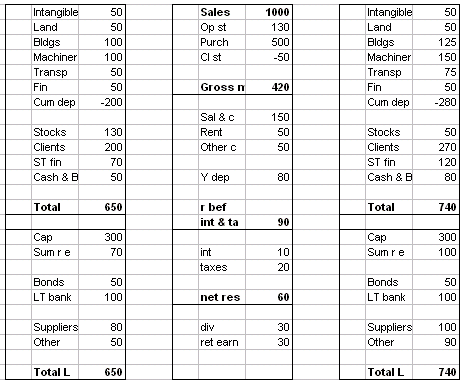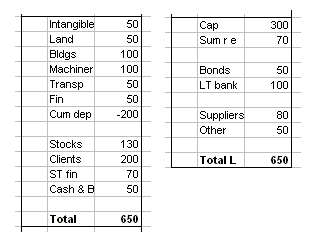General accounting
XII. 43. Ratios (part 2)
Video
We saw in the last lesson that there are four categories of ratios:
- profitability ratios
- liquidity ratios
- efficiency ratios
- investment ratios
And we already studied the main profitability ratio, called the ROCE (= return on capital employed).
All profitability ratios are of the form

The ROCE was

Another similar ratio is the ROE (= return on equity)

As usual, for the denominator we mean the average value over the year, computed as the beginning value plus the end value divided by 2.
Example of calculation of ROE. Let's consider the following set of accounting figures

The net result of the year is 60. And the average value of Equity is (370 + 400)/2. So we have

The ROE is not a very meaningful measure because the Equity that we use is a book value, that is a value produced by accounting. Most of the time it is quite different from the market value of all the shares of the firm, which is the market value of Equity.
The same comment applies to the ROCE, even though the ROCE is slightly more meaningful in the sense that the book Equity is indeed a measure of the effort the firm made to obtain it.
With the profitability ratios, and more generally the concepts of cash and of time, we are reaching the limits of Accounting as a descriptive model of the firm.
- In Accounting, time plays a simplistic role. And so does cash.
- We shall see in Finance a more sophisticated role of time, even though the models presented in academic textbooks are still wanting. It is an open subject for research.
- As regards cash, this is a subject of research in Money. It would be a mistake to believe that everything is known and understood about money. For instance, look at the disasters caused by the unique currency in the Eurozone.
Remember that all financial and monetary innovations in history happened spontaneously (with the exception of central banking).
Since the beginning of the XXIst century, deep changes are underway in moneys (currencies) worldwide. Once again they are spontaneous. It is likely that the moneys we will be using in a decade or two will no longer be Nation-State controlled currencies.
As always with new theories, to describe more convincingly financial and monetary phenomena we will need to get rid of some concepts and principles that seem absolutely indisputable.
Book value and market value of shares. In the following balance sheet

suppose the initial capital was made of 300 shares, each with a face value of 1000€ (all figures are in thousands of euros).
The value today of each share is not 1000€, nor is it 370/300 K€ (which would yield 1230 €).
They are more or less liquid, but they have a market value which is representative of the market appraisal of the value today of the future cash flows the firm will generate.
Other profitability ratios
The return on assets is defined as

It is not a very meaningful ratio, because as we saw the assets are an heterogeneous list of things. And the total assets are a poor measure of the means employed by the firm.
An even worse ratio, even though it is often met in economic literature, is the return on sales

Indeed, the sales are not a good measure of the size of a firm (the value added would be much better), and certainly a very bad one of the means used by the firm.
Liquidity ratios.
The main liquidity ratio is the "current asset ratio". Its definition is

We want this ratio to be not much smaller than 1. Here is the reason. Think of the current assets as a reservoir of liquidities.

It is used among other things to pay the creditors's bills. So we need to make sure that we always have the cash to pay current liabilities as they come due. (Let's equate "current liabilities" to "free creditors", which is almost exact.)

If the current assets are much less than the current liabilities, we then need to be pretty sure of our cash inflows, and we incur the risk of not having the cash when we need to pay something.
Whereas if we have current assets roughly of the same size as current liabilities, they play a buffer role which makes us safe.
Therefore the current asset ratio should not be much less than 1.
Conversely, if it is much more than one, this means that we don't use enough of our free credit. Therefore it is a waste of costly funds.
So a good value of the current asset ratio is around 1.
There is a variant of the current asset ratio, called the "acid test ratio". Given that we want to compare liquidities on the asset side to the current liabilities, in this ratio we put on the numerator [ current assets - stocks ], because stocks are less liquid than the other current assets:

Efficiency ratios.
They don't use profitability measurement, but they assess the efficiency with which we use our assets. The two main efficiency ratios are the stock turnover, and the debtor collection period.
We begin with the stock turnover. Our stock feeds the COGS. To make an efficient use of our stock means to keep relatively little stock to serve the sales (and therefore the COGS).

The definition of stock turnover is

(as usual we shall take the average stock).
In the above figures, we have COGS = 580, and average stock = 90, so the stock turnover is

That is, on average (if we were considering steady flows of everything) the goods stay a little less than 2 months in stock.
Because stock management is an important aspect of managing a firm, and because low stock can be a good sign as well as a bad sign, we devote next lesson to stock management.
Client paper. We want to have not too much client paper (because like everything else it has to be financed). So we want to collect quickly the cash from our clients to whom we granted credit. The "debtor collection ratio" (or "debtor collection period") is defined as

Sometimes it is expressed in number of days (compared to a whole year). To obtain this measure, we simply multiply the above ratio by 365.
Calculations: we need to know the Sales on credit. It is not a figure given in the above documents, but let's assume all sales were on credit.
Then the debtor collection ratio was [ (200 + 270)/2 ] / 1000 = 23,5%. Expressed in number of days, this yields 86 days. Almost 3 months! We see that our clients don't pay us very well.
Investment ratios.
We shall not comment much on investment ratios in Accounting, because, as we said, financial concepts are poorly grasped by Accounting. We shall study financial concepts (including some ratios, although they are usually rather crude in their treatment of time) in a Finance course.
Let's mention, however, one common "investment ratio": the PER (= Price Earning Ratio), also sometimes noted P/E.




